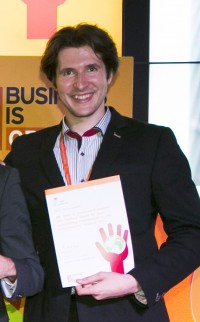
School graduate Flaviu Cipcigan fought off stiff opposition to be awarded a prize at a ‘Dragon’s Den’ style competition during the UK Trade & Investment (UKTI) Entrepreneurs’ Festival in Manchester. Flaviu was part of the ‘FiTogether’ team, which comprised participants from six countries and five continents.
FiTogether’s innovative concept aspires to develop an interactive app which will instantly connect like-minded fitness enthusiasts to make fitness more fun, social and effective. The team’s impressive skills secured them the Best Pitch prize, which includes a two-hour mentoring session with the Business Growth Hub/Enterprise Lab to help them develop their own ideas.
“Winning this award has given us all great confidence in our entrepreneurial ability. Not only was this competition a great opportunity to work as a team with people from all over the world, it allowed us to each develop our business acumen too.” Flaviu Cipcigan
Flaviu is one of the School's industry-supported graduate students. He works with The National Physical Laboratory and IBM Research in the US.
Entrepreneurial support for students and recent graduates
The international enterprise competition was held to mark the launch of The Sirius Programme. Spearheaded by UK Trade & Investment (UKTI), The Sirius Programme is a pioneering scheme to bring the world’s best entrepreneurial talent to the UK.
The 12-month start-up support and acceleration package is open to students and recent graduates with an early-stage business idea or business plan. Successful applicants receive a full range of support including investment, a place in one of the world’s best business accelerator programmes, mentoring and logistical help with relocating to the UK. Places will be allocated each month between October 2013 and January 2014, and the deadline for entries for November’s intake is 31 October 2013.
Nick Baird, Chief Executive of UKTI praised Flaviu on his achievement:
“I congratulate Flaviu on winning this award. The calibre of all the entrants from the Festival was superb, but Flaviu and his team had the edge across the board. It is great to hear that they will be applying for the Sirius Programme as this is be one of the most comprehensive start-up support packages offered globally, and the best in Europe. The quality of the participants at the Festival highlighted the potential and enthusiasm of these young entrepreneurs and we look forward to supporting entrepreneurs like them as they establish their business ventures in the UK.”
Image gallery
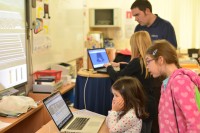
EPCC, the supercomputing centre based in the School, took part in Bang Goes the Borders, a free science festival held in St Mary's Primary School in Melrose. EPCC's Mario Antonioletti reviews the day.
This was my first time at Bang Goes The Borders, but my fellow EPCC'ers Iain Bethune and Terry Sloan were old hands, both having done it last year. We set up four stands in a classroom we were allocated, with the first overseen by Terry who ran two exercises showing the benefits of using parallelism to solve problems.
Parallelism games
Terry’s first demonstration asked volunteers to sort balls according to colour. A single person, usually a child, is asked to see how many balls they can sort in a minute, then the task is repeated with more than one person. In nearly all cases the task can be done more quickly with more people, ergo you can use multiple processors to solve a problem faster. The ball-sorting usually works very well as it gets the naturally competitive nature of kids going.
There was also a card-sorting demonstrator, which is a little bit more involved as it requires coordination between the "processors" so is more suitable for a slightly older age group.
Hardware
Having demonstrated the benefit of parallelism, I showed attendees a number of processor boards of previous machines that have been hosted by EPCC - there was a Thinking Machines CM-200 board, a Cray T3E board (which was liquid-cooled), a Cray XT board and, to compare them with something that might be more familiar and found at home, the insides of a Dell desktop.
There was some interest among the audience in all of this, but perhaps not so much for the younger age group who were more attracted by the aesthetics of the component arrangement, liked poking about the exposed electronics or trying to lift the Cray T3E board, and were fascinated by its heaviness.
The hope was that having experienced the benefit of working in parallel, actually seeing the boards with multiple processors would link the two experiences together.
A third desk had a rolling presentation of the types of problems that are typically run on such massively parallel systems - from climate modelling and computational biochemistry to fluid dynamics and cosmology!
Close to this was the freebies desk which was the second most popular spot, second only to the dinosaur racing.
Dino racing
By far the biggest crowd puller for us was the dinosaur racing, with a mass of people surrounding Iain at the stand. This was the second outing for this Virtual Palaeontology demo: on the EPCC blog you can read about its British Science Festival 2013 (BSF13) debut and about EPCC's presence at BSF13. A number of improvements and fixes were done post-BSF13, which further enhanced the activity. The demo was run off a node on HECToR so people were also able to use a supercomputer. Many kids came back several times during the day to try to improve on their first dinosaur design.
It is difficult to determine how many people saw our stands, although the organisers estimated that numbers were up 20-40% over last year, with over a thousand people circulating through the entire event. Certainly we must have given several hundred their first hands-on experience of supercomputing! It was a long and exhausting day, but we hope that some of the young people who visited our classroom will go on to do science in later life and, who knows, may even come to work at EPCC.
You can find out more about EPCC's work, including its outreach activities, on the EPCC blog.
Photography by Mario Antonioletti and Keith Morgan.
Image gallery

The seven-week course, entitled The Discovery of the Higgs Boson, describes the scientific advancements that led to the theoretical prediction in 1964, the building of the Large Hadron Collider and the detection of the boson. It will also highlight the cross-fertilisation between theory and experiment in particle physics during the past, and explore some of the implications for the future.
The course, which is organised by the School's Luigi Del Debbio and Christos Leonidopoulos, will feature interviews with Prof. Higgs and filmed lectures by a team of world-class physicists at the Higgs Centre for Theoretical Physics. Students can then debate what they have seen by using dedicated online discussion spaces, as well as via social media.
"I am very pleased that Peter’s incredible work will now be available to a worldwide audience of learners to analyse and discuss. Peter’s research has provided us with profound insight into the building blocks of the Universe and this course will allow anyone with a computer and access to the web to take part in the exciting and revolutionary times that we live in." Prof. Arthur Trew, Head of School for Physics & Astronomy
“There is tremendous interest among the general public in Higgs and his boson. The Higgs MOOC gives us at the Higgs Centre the opportunity to reach a wide international audience, and hopefully convey the beauty of the theoretical ideas, the excitement of the discovery, and the possible implications for our understanding of the Universe.” Prof. Richard Ball, Director of the Higgs Centre
The University of Edinburgh is offering the course as its first Massive Open Online Course (MOOC) via the FutureLearn platform, a partnership of 23 leading universities, along with the British Museum, British Council and British Library, which offers learners the opportunity to access high-quality courses for free.
The Higgs boson
Prof. Higgs developed his theory of the particle that bears his name when he was a researcher at Edinburgh in the early 1960s. Since then, the Higgs boson has formed a crucial strand of particle physics theory.
In July 2012, scientists at the European Organization for Nuclear Research (CERN), including many from Edinburgh, announced results which indicated the existence of the Higgs boson. In March 2013, CERN said that analysis of more data confirmed even more strongly that the new particle is indeed the Higgs boson.
Online learning at Edinburgh
The University of Edinburgh has led the way in online learning and was the first university in the UK to offer MOOCs via the Coursera platform, which brings together universities from around the world to offer free Higher Education-standard courses across a diverse range of subject areas.
During the first round of Edinburgh’s courses, more than 300,000 people signed up to study from a selection of six MOOCs.
By joining the FutureLearn network, Edinburgh will be able to offer MOOCs to an even greater number of learners around the world.
Edinburgh will be offering a selection of new and existing MOOCs in late 2013 and throughout 2014, via the Coursera and FutureLearn platforms.
The Higgs MOOC offers a hugely exciting opportunity for learners to experience university-standard courses, at no cost to themselves. Over the next 12 months, we will be announcing details of more than a dozen MOOCs, across a range of subjects, reinforcing Edinburgh’s position as a world-leader in online learning. Prof. Sir Timothy O’Shea, Principal of the University of Edinburgh
Quality assured
Edinburgh’s MOOCs have been developed by senior academic staff and their content is checked using the same quality assurance methods as for our other courses. The courses do not offer a credit towards entrance to the University of Edinburgh, but are taught to the same standards as our other online courses.
Online learning at Edinburgh
MOOCs complement the University’s substantial offering of high-quality online postgraduate programmes. We offer Postgraduate Certificate, Postgraduate Diploma or Masters qualifications across a broad range of subject areas. These involve the same level of work overall as our on-campus programmes, and the qualification awarded is of equal value.
Our online learning courses also offer flexible exit routes, allowing you to shape your academic journey to suit your needs.

We're here to help all our new students ('Freshers') who will be joining us this month.
Freshers' Welcome meeting
Tuesday 10th September, 10am-12pm, Lecture Theatre A, James Clerk Maxwell Building, King's Buildings.
Our Freshers' Welcome meeting aims to answer all your questions about studying at the School of Physics & Astronomy. It is open to all students who are starting a Physics degree with us, whether you are entering First Year or taking direct entry into Second Year.
Visiting Students' meeting
Tuesday 10th September, 2pm-4pm, Room 4316, James Clerk Maxwell Building, King's Buildings.
This meeting is especially for those of you who are here as 'visiting students' (with us for 6 months or a whole year).
Both meetings are designed to give Freshers all the information they need, for example the name of your personal tutor and the structure of your degree.
Please try to make the most of the many activities during your first week. It's a fantastic opportunity to get to know lots of people, join student societies and maybe join a club for a sport you would have never imagined yourself doing!
An international team of researchers from the UK Centre for Astrobiology (UKCA) and Carnegie Institute of Washington went to Disko Island, Greenland, in August to explore its potential for deep carbon research.
Their aim was to provide new, well-characterised material for research projects focused on the deep carbon cycle, representing an international effort to provide samples and data from remote and fascinating locations.
Disko rocks
Greenland is well known as a geological wonderland. Disko Island off the west coast of Greenland is no exception, and it offers a unique opportunity to investigate carbon sources and fluxes within reservoirs ranging from the Earth’s mantle to the deep subsurface biosphere.
The basalts here contain unusual carbon species that are rare on the Earth’s surface. Their formation has remained enigmatic for decades, yet can shed light on the role and speciation of carbon in the Earth’s mantle. Disko Island is also home to thousands of geographically-isolated deep thermal springs. These provide a ‘window’ into the subsurface biosphere for the study of microbiological communities dwelling within the Earth’s crust, and particularly how they fix and cycle carbon.
Exploring new environments
The field-team of four (Claire Cousins and PhD students Mark Fox-Powell and Casey Bryce from Edinburgh, and Sami Mikhail from the Carnegie Institute of Washington) explored and sampled environments ranging from subglacial sediments to radioactive thermal springs. They also collected geological samples ranging from run-of-the-mill basalts to those containing unusual reduced carbon phases and native metals.
The samples will eventually be catalogued and listed on the System for Earth Sample Registration, and made available to the international community under the “DCO Collection”, as well as providing material for on-going research here in the UKCA and the Physics of Living Matter group.
Find out more
More details of this expedition, including an expedition blog, can be found on Claire's blog.
This expedition was funded by the Deep Carbon Observatory (DCO) and UK Centre for Astrobiology (UKCA), and was led by Claire Cousins (UKCA) in collaboration with Sami Mikhail (CiW), Adrian Jones (UCL), Charles Cockell (UKCA), and Andrew Steele (CiW).
Image gallery
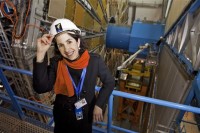
Fabiola Gianotti, former spokesperson of the Atlas collaboration who co-announced the discovery of the Higgs boson at CERN in July last year, has been appointed an Honorary Professor in the School of Physics & Astronomy.
"I am very honoured and pleased to be appointed Honorary Professor at this prestigious School, which has such great historical traditions and excellent theoretical and experimental groups. I look forward to collaborating with the Edinburgh physicists, in particular with the very strong and lively ATLAS group". Fabiola Gianotti
Fabiola will be associated with the School's Experimental Particle Physics Group, which carries out research at both the ATLAS and LHCb experiments at the LHC. She will work with Edinburgh staff and PhD students based at CERN and visit the School for specialist lectures.
Fabiola is a member of the International Advisory Committee of the Higgs Centre for Theoretical Physics at the University of Edinburgh, and has been a colleague of Peter Higgs himself for some time.
"We are delighted that Fabiola is now an Honorary Professor in our research group. Fabiola is very enthusiastic and we look forward to seeing her here in Edinburgh in the autumn." Peter Clarke, Edinburgh Particle Physics Research Group
"We are very excited Fabiola will be joining our ATLAS research team as a visiting professor. Her vast knowledge of the ATLAS experiment will be a great asset to our research on the Higgs boson and in searching for any new phenomena the LHC may reveal." Victoria Martin, Edinburgh Particle Physics Research Group
Distinguished career
Fabiola has had a distinguished career in particle physics. She gained her PhD in 1989 from the University of Milan. As a post-doctoral researcher her first project was the R&D for what later became the ATLAS experiment at the Large Hadron Collider (LHC). In 1996 she joined the ALEPH experiment at the LEP-II (Large Electron Positron) collider where she worked upon the search for evidence of supersymmetric particles, which are candidates for dark matter.
She became a CERN Fellow and then a member of the CERN staff in 1996. After a period of detector development she became involved in the many physics preparation studies needed in advance of the first proton beams at the LHC as well as work on the liquid Argon calorimeter. She was elected “Physics Coordinator” of ATLAS from 1999-2003, Deputy Spokesperson from 2004-2009, and then in 2009 she was elected as the Spokesperson of ATLAS, a position she held until she stepped down in March 2013. This position is one of the most senior leadership positions in the field of experimental particle physics, where she was responsible for a collaboration of nearly 3000 physicists from over 170 international Institutions. Her role has of course been central to the most recent high point of the LHC programme, the discovery of the Higgs boson.
Prizes
In 2012 she was awarded the title of "Grande Ufficiale al merito della Repubblica" by the Italian President Giorgio Napolitano. She received the Special Fundamental Physics Prize (funded by the Milner Foundation), awarded jointly to the ATLAS and CMS Spokespersons for their leadership that led to the discovery of the Higgs Boson, and was elected as a member of the Italian “Accademia Nazionale dei Lincei” in 2012.
In 2013 Fabiola was awarded the Italian “Nonino Prize” and the Enrico Fermi prize of the Italian Physical Society.
Image gallery

Soft Matter journal has published a paper that details a School research team's investigations into the mechanical properties of emulsions that are stabilized by micron-sized particles.
The team, based in the School's Institute for Condensed Matter and Complex Systems (ICMCS) included two undergraduate students: Louison Maurice, an exchange student from Lyon who is currently teaching Physics and Chemistry in a secondary school in France, and Ryan Maguire from Edinburgh who is now a Nuclear Safety Consultant.
"It was very interesting for me to be part of this project, because, thanks to it, I found out all about the research process, from the idea and the experiment to the publication of a paper." Louison Maurice
Job Thijssen explains the research work described in the paper.
We have investigated the mechanical properties of emulsions stabilized by micron-sized particles. Emulsions consist of droplets of a liquid dispersed in an immiscible liquid, eg water in oil. Such materials are ubiquitous in the food, personal-care, agricultural, pharmaceutical and petrochemical industries. Typically, a third component is needed to stabilize an emulsion, eg mustard in a vinaigrette of vinegar and olive oil. Conventional stabilizers tend to be surfactant molecules, ie similar to those in washing-up liquids. However, recent years have seen an increasing interest in emulsions stabilized instead by particles, known as Pickering emulsions, mainly because they feature superior functionality and shelf-life.
Mechanical properties
The mechanical properties of emulsions are crucial to their processing and use. For example, food spreads should not flow off the knife, but should spread easily onto a sandwich. The mechanical properties of particle-stabilized emulsions are not yet fully understood, as they arise from a complex interplay between the elasticity of the liquid-liquid interface at the droplet surface and interactions between the particles on that surface. Notably, we have used particles that mutually interact as hard spheres in the continuous phase under ambient conditions, ie they only repel one another upon contact. This well-defined interaction has helped us model their contribution to the mechanical properties of the corresponding Pickering emulsions.
Increased understanding
In our study, we have compressed Pickering emulsions using a centrifuge with the aim of better understanding their behaviour in mechanical equilibrium; this is also important in interpreting flow experiments on similar samples. In addition, we have developed a transparent Pickering emulsion, allowing us to characterize the structure of our samples in 3D using microscopy (see image). Finally, we can explain our data using a quantitative model in which we have incorporated interdroplet liquid films with a thickness on the scale of the particles and repulsive interactions across these films. We suggest that this repulsion between droplets is due to the energy-expensive deformation of the liquid-liquid interface between particles on one droplet due to compression against a neighbouring droplet.
Applications in porous materials
Finally, we discuss the relevance of our results to the rational design of porous materials. Using centrifugation (see image), we can squeeze our emulsions into foam-like structures, which have been suggested as templates for porous materials with applications in separation techniques, catalysis, thermal insulators, metal foams and electrodes. We can control pore size via the droplet radius, and wall thickness via the particle size and/or centrifugation speed. Moreover, the mechanical properties of these structures are crucial to their use as materials templates. For example, we have shown that changing the interactions between the particles may result in significant post-centrifugation expansion, with obvious consequences for post-processing.
The paper appears in Soft Matter, 2013,9, 7757-7765; DOI: 10.1039/C3SM51046H
Image gallery
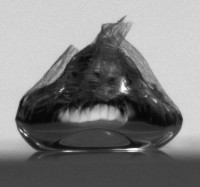
A Scottish research team that includes the School's Prof. Cait McPhee and Postdoctoral Research Fellow Keith Bromley has uncovered the workings of a 'bacterial raincoat' that helps to protect bacteria from the changing environment in which they live.
The findings of the team, led by Dr Nicola Stanley-Wall and Professor Daan van Aalten from the College of Life Sciences at Dundee, are published today in the journal Proceedings of the National Academy of Sciences.
"Myself and Keith Bromley were responsible for measuring the interfacial properties of the protein, showing that it formed a robust film very quickly at an oil/water interface. The film it forms crumples like cellophane, and we can change how it partitions to the interface by mutating the protein, which gives us a lot of control. Our findings have implications for antibiotic resistance, and proteins like this have also found uses in industrial applications."
Prof Cait McPhee, of the School's Institute for Condensed Matter and Complex Systems (ICMCS)
Read the University of Dundee press release.
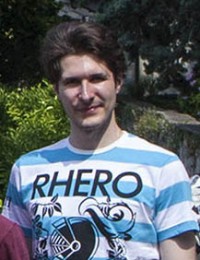
Congratulations to Flaviu Cipcigan, who won the award for the best presentation at the International School of Physics "Enrico Fermi". Flaviu presented work by the research group in which he is studying and his own PhD results.
The research group is working on a simplified quantum mechanical model for the water molecule, while Flaviu's PhD focuses on the development of this model and exploring its properties.
One of the School's industry-supported graduate students, Flaviu works with The National Physical Laboratory (NPL) and IBM Research in the US. The research group is led by Prof. Jason Crain (Edinburgh/NPL) and Prof. Glenn Martyna (IBM), in collaboration with Dr Vlad Sokhan (NPL) and Dr Andrew Jones (Edinburgh/NPL).
Find out more
Scroll down to the bottom of this page for a summary of Flaviu's first year of research, his winning presentation and poster.
Image gallery
This month, a team of four UK scientists, including Claire Cousins from the UK Centre for Astrobiology (UKCA) based at the University of Edinburgh, went to Iceland to test a prototype of the Panoramic Camera (PanCam) instrument, which will form a major component of the European Space Agency’s 2018 ExoMars rover.
Sending a robotic rover to explore the surface of Mars is a significant challenge, and an endeavour that requires many years of preparation, particularly of the various instruments that will become part of the rover payload.
Minerals on Mars
Dr Cousins, along with colleagues from Aberystwyth University, Birkbeck College, and University College London, spent two weeks working at the Krafla volcanic region of northern Iceland. Here, the terrain is characterised by basaltic rocks that have undergone extensive aqueous alteration, producing many of the same mineral assemblages that have been identified on Mars. Such terrains are evidence of environments that, at least on Earth, are home to thriving microbial communities. This makes this location an ideal site for testing instruments that will be on future astrobiology missions, such as the ExoMars mission, which will need to identify rocks and sediments that were produced in past habitable environments. Volcanic processes are particularly relevant to past Martian environments, as volcanism has been so prevalent throughout Martian history.
PanCam science
The PanCam instrument does more than just image the rover’s surroundings. Two wide-angle cameras set 50cm apart provide stereo vision, meaning the terrain can be imaged in 3D. It also has the ability to view the terrain at many different wavelengths, from the visible to the near-infrared (VNIR), providing information on the spatial distribution of particular mineral types. Finally, PanCam has a High Resolution Camera, which can provide detailed images of particular features on a distant rocky target. All together, these various data products enable planetary scientists to carry out geological investigations of the surrounding terrain, which is crucial for target selection (ie where to send the rover to investigate further) when exploring the Martian surface.
Ground-truthing
The aim of the Iceland fieldwork was to test PanCam at sites where the team could take samples (for laboratory analysis), and other in-situ data, in order to establish the scientific capabilities of the instrument. These samples will be analysed with XRD and Raman Spectroscopy to identify their mineralogy, and with VNIR reflectance spectroscopy to see how their spectral properties compare with PanCam multispectral data. Additionally, in-situ reflectance spectra were measured from PanCam targets using a field reflectance spectrometer loaned from the NERC Field Spectroscopy Facility, also based at the University of Edinburgh in the School of Geosciences. All this information will eventually feed into the PanCam data processing pipeline, ultimately fine-tuning the instrument and its software so it can be used confidently on the surface of Mars.
"Testing instruments on these types of terrains is the closest we can get to simulating the Martian surface geology. This was a very successful trip, not least due to the combined expertise of the team that included geology, remote sensing and engineering. I'm hopefull it'll lead to more Mars analogue field-testing of future instrument concepts." Claire Cousins, UK Centre for Astrobiology
Find out more
More details of this research, including an up-to-date web blog detailing the fieldwork itself, can be found at http://clairecousins.wordpress.com/category/fieldwork/iceland/.

